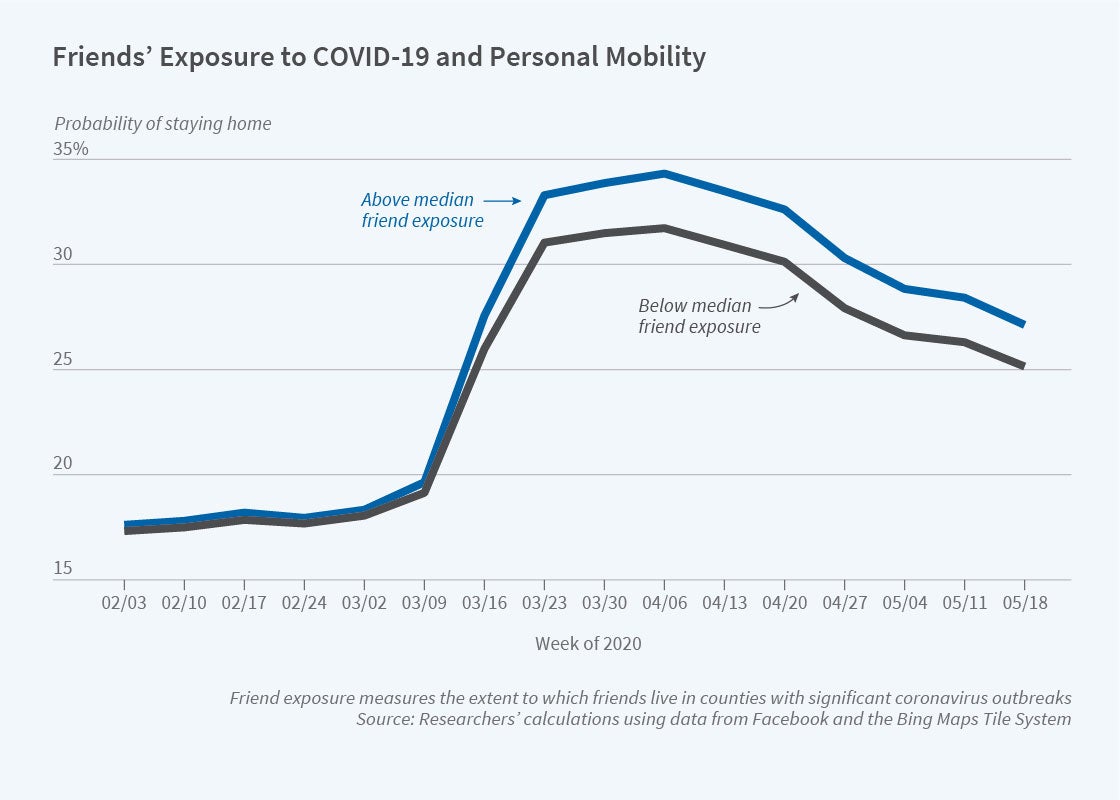Social Media Contacts in Virus Hotspots Encouraged Self-Isolation
Individuals with friends exposed to COVID-19 outbreaks were more likely to stay at home, and less likely to oppose economic shutdowns to contain the virus.
Designing a public health response to the COVID-19 pandemic requires an understanding of the factors that influence individual choices affecting the spread of the virus. In Social Networks Shape Beliefs and Behavior: Evidence from Social Distancing during the COVID-19 Pandemic (NBER Working Paper 28234), Michael Bailey, Drew M. Johnston, Martin Koenen, Theresa Kuchler, Dominic Russel, and Johannes Stroebel explore how personal connections and social network exposure to COVID-19 cases affect social distancing behavior.
The researchers use de-identified data from Facebook that provide information along three dimensions: movement patterns, public posts on the platform, and membership in public Facebook groups. The first of these is used to construct measures of social distancing behavior, while the latter two provide information on beliefs about COVID-19 and related public health measures, and can thus shed light on the mechanisms through which social networks affect behavior.
The researchers find that US Facebook users whose friends lived in areas with worse coronavirus outbreaks on March 15, 2020, reduced their mobility in subsequent months more than otherwise-similar users with friends in less-affected areas. A one standard deviation increase in an individual’s friend-exposure to COVID-19 cases early in the pandemic was associated with a 1.2 percentage point increase in the probability of staying home on a given day. A similar pattern was observed as the pandemic progressed in later months, and the location of hotspots changed: in every month, it was those individuals with the largest changes in friend exposure to COVID-19 who reduced their mobility the most. The researchers’ use of mobility data at the individual rather than aggregate level allows them to rule out alternative explanations for their findings, such as differential ability to work from home in some locations, which might not reflect a causal link between social network friendships and distancing behavior.
The researchers then explore the mechanism behind the observed relationship between friend exposure to COVID-19 and social distancing. Using data on Facebook posts and group memberships, they find that friend exposure raised awareness about the risks of the disease. In particular, users with higher friend exposure to COVID-19 were more likely to post about the coronavirus and less likely to make comments that opposed social distancing. They were also less likely to join Facebook groups advocating for a reopening of the economy during the early months of the pandemic.
The researchers conclude that exposure to COVID-19 increases an individual’s willingness to reduce mobility at least in part by raising awareness of the risk associated with COVID-19 and thus shifting beliefs about the need to engage in preventative health measures. The findings highlight that social networks play an important role in determining individuals’ beliefs and behaviors.
— Lauri Scherer



